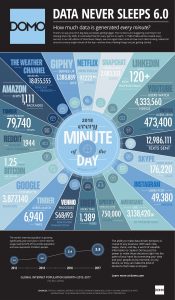You may have heard Bit & Byte before, but do you really know what is it? How does the computer storage system work?
We are continually generating a lot of data every second, hence there should be a storage system strong enough to handle it all. In this post, we are gonna talk about this storage system.
“Over 2.5 quintillion bytes of data are created every single day, and it’s only going to grow from there. By 2020, it’s estimated that 1.7MB of data will be created every second for every person on earth.”

In the next article, we will also talk about the next generation of computer storage system (Quantum Computing.)
What is Bit & Byte?
A Bit is the smallest or basic unit of computer information which has only two values “0 or 1”. These two values can also be defined as “true or false” and “yes or no”, depending on the binary code.
A Byte is the smallest unit of memory. One byte is made up of eight bits, that means one byte is one character of information and is comprised of eight bits (eight 1’s or 0’s).
Here is a table to clear out your confusion.
Unit\Value
| Unit | Value |
|---|---|
| 0 (Off) or 1 (On) | 1 Bit |
| 8 Bits | 1 Byte |
| 1,024 Bytes | 1 Kilobyte |
| 1,024 Kilobytes | 1 Megabyte |
| 1,024 Megabytes | 1 Gigabyte |
| 1,024 Gigabytes | 1 Terabyte |
| 1,024 Terabytes | 1 Petabyte |
| 1,024 Petabytes | 1 Exabyte |
| 1,024 Exabytes | 1 Zettabyte |
What is 32 bit / 64 bit?
Many times while downloading a software, we get to see two options – ” download in 32 bit” or “download in 64 bit”. So, let’s see what is 32 bit / 64 bit?
The terms 32-bit and 64-bit define the fixed-size piece of data a processor can transfer to and from memory. So, in theory, 64-bit computers can handle data twice as fast 32-bit systems.
The term for 64-bit computer architecture is x64, and the 32-bit computer architecture is most commonly known as x86and was based on the Intel 8086 / 8088 processor. The Intel 8086 / 8088 processor was found in the original stand-alone Pac-Man video arcade console.
The storage system:
Different users can have different storage requirements. Knowing what a computer is going to be used for (and of course many computers are used for a variety of purposes) is hence very important when planning storage requirements.
So let’s continue with some of the available storage devices and technologies.
- HARD DISK STORAGE: Spinning hard disk (HD) drives are today the most common means of high capacity computer storage, with most desktop and laptop computers still relying on a spinning hard disk to store their operating system, applications programs, and at least some user data.
- RAID: On servers and high-end PC workstations (such as those used for high-end video editing), at least two hard disks are often linked together using a technology called RAID. This stands for “redundant array of independent disks” (or sometimes “redundant array of inexpensive drives”), and stores the data in each user volume on multiple physical drives.
- DIRECT ATTACHED STORAGE (DAS): Except where two internal hard disks are considered essential on the basis of performance, a second hard disk is a today most advisably connected as an external unit, or what is sometimes now known as a “DAS” or direct attached storage drive
- OPTICAL DISK STORAGE: Almost all optical storage involves the use of a 5″ disk from which data is read by a laser. Optical media can be read-only, write-one, or rewritable, and currently exists in one of three basic formats – CD(compact device), DVD(digital versatile disk), BD(blue ray disk).
- SOLID STATE DRIVES: Solid state storage devices store computer data on non-volatile “flash” memory chips rather than by changing the surface properties of a magnetic or optical spinning disk. With no moving parts solid state drives (SSDs) — are also very much the future for almost all forms of computer storage.
- FLASH MEMORY CARDS: Flash memory cards were developed for digital cameras and mobile computers. They consist of a small plastic package with a contact array that slots into a camera or other mobile computing device, or an appropriate memory card reader.
- SD CARDS: SD cards are the most popular flash memory cards now on the market, and come in so many variants that they do require some explanation. SD cards come in three physical sizes. Standard size SD card, Mini SD card, Micro SD card.
- USB MEMORY STICK: USB memory sticks (or USB memory keys, USB memory drives, or whatever you choose to call them!) are basically a combination of a flash memory card and a flash memory card reader in one handy and tiny package.
- NETWORK AND ONLINE STORAGE: Files stored and/or backed-up online are still saved to a hard disk rather than to some magic, new alternative media. However, the fact that the disk is located remotely to your computer, can be accessed from anywhere and is probably backed up by the service provider(?), can make online storage and back-up very attractive.
The last few years have seen the death of the floppy disk and for many digitizations of photography and their music collection.
In one of the next article, we will talk about the next generation of the computer system – (Quantum Computing).
So, Stay tuned and comment your thoughts below. See you soon.
Thank You.

Leave a Reply